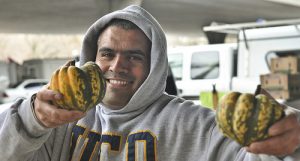Lectionary Reflection for the 7th Sunday after Pentecost, July 31, 2011
And all ate and were filled; and they took up what was left over of the broken pieces, twelve baskets full. Matthew 14:20
Why do you spend your money for that which is not bread, and your labor for that which does not satisfy? Listen carefully to me, and eat what is good, and delight yourselves in rich food. Isaiah 55:2
The texts from Isaiah and Matthew have me thinking about food and its ability to include or exclude, to feed, fuel, and feast. While there are many ways a preacher or teacher can approach the lessons this week, one approach is to focus on spiritual and physical hunger and on want and plenty in light of our call to be stewards of the gospel and disciples of Christ.
 First, let me pose a few questions. Do you know what it is to be hungry? Have you ever wondered where your next meal would come from, or how you might feed your children from an empty pantry? If not, are you aware of how many people are in this situation? According to worldhunger.org, there were 925 million hungry people in our world last year. In developed nations, 19 million people were hungry, while in Sub-Saharan Africa the number was 239 million, and in Asia and the Pacific 578 million people experienced hunger in 2010.
First, let me pose a few questions. Do you know what it is to be hungry? Have you ever wondered where your next meal would come from, or how you might feed your children from an empty pantry? If not, are you aware of how many people are in this situation? According to worldhunger.org, there were 925 million hungry people in our world last year. In developed nations, 19 million people were hungry, while in Sub-Saharan Africa the number was 239 million, and in Asia and the Pacific 578 million people experienced hunger in 2010.
In the United States, one of the world’s wealthiest nations despite our staggering debt, nearly one in four children lives in homes that struggle to put food on the table. In this “land of plenty,” Bread for the World notes that 51.4 percent of Americans will live in poverty at some point before the age of 65.
Another pressing matter is the growing reality of “food deserts” in the United States. Click here to see an interactive map. A food desert is basically an area where residents lack access to adequate nutrition. This can be the result of a combination of factors: lack of resources, transportation, places to purchase good food, and/or lack of knowledge about nutrition. Obesity rates and related health problems are skyrocketing.
The issues are many and complex, and the average person in the pew may be experiencing a range of emotions from frustration to caring fatigue to blissful avoidance of the reality of hunger. Sadly, it will take much more than stocking food pantries and feeding programs to address the root problems.
 What does all this have to do with the texts for this week? Actually, it has quite a lot to do with the lessons on both practical and spiritual levels. Jesus instructs his disciples to feed the crowd gathered–practical, indeed. Even though resources available are meager, all are fed and leftovers are plentiful. Note how clueless the disciples were about their inability to make a difference and provide the crowd with life-sustaining food. They were ready to send them packing to find their own supper. The disciples, as faithful and logical as they were, could not see beyond scarcity to abundance. I would argue that we are in much the same situation today. The problem of feeding the hungry seems so large that it is easy to dismiss it or throw a little cash at it and move on. What might happen instead if we threw a few seeds in the ground of a community garden and spent time getting to know our hungry neighbors? What if we entered into real relationship with them, hosting meals and learning to cook simple, healthful food in our church, community, and home kitchens? Think of the difference in perspective this approach would also offer.
What does all this have to do with the texts for this week? Actually, it has quite a lot to do with the lessons on both practical and spiritual levels. Jesus instructs his disciples to feed the crowd gathered–practical, indeed. Even though resources available are meager, all are fed and leftovers are plentiful. Note how clueless the disciples were about their inability to make a difference and provide the crowd with life-sustaining food. They were ready to send them packing to find their own supper. The disciples, as faithful and logical as they were, could not see beyond scarcity to abundance. I would argue that we are in much the same situation today. The problem of feeding the hungry seems so large that it is easy to dismiss it or throw a little cash at it and move on. What might happen instead if we threw a few seeds in the ground of a community garden and spent time getting to know our hungry neighbors? What if we entered into real relationship with them, hosting meals and learning to cook simple, healthful food in our church, community, and home kitchens? Think of the difference in perspective this approach would also offer.
Don’t get me wrong; I am not shooting down food pantries. It is both good and necessary to collect canned goods and non-perishables to distribute, to fund feeding programs, and to encourage people to participate in tangible ways. Doing so meets an immediate need to fill a hungry belly, but it does nothing to fill the hole in a person’s dignity or to establish life-nurturing relationships and real change. Relationships are tough to build and risky to establish. Even the disciples had to move among the crowd and get out from behind the hem of Jesus’ cloak.
In looking at the Isaiah text and the call to buy without money, to purchase good and lasting food rather than junk, I am reminded of what we face in the United States with the prevalence of junk food, food deserts, and poor nutrition. It is easy to look down one’s nose at the obese child munching on a supper of additive-filled hotdogs, cheap white buns with little nutritional value, a side vegetable of potato chips, and a big gulp of sugary fruit punch, saying “No wonder the little bugger is fat,” or to blithely criticize the single mom who gives her toddler a bottle full of apple juice at night that will speed tooth decay at an alarming rate.
 What is more difficult is to work for lasting change in our food supply chain, to help parents who may be working two and three minimum wage jobs learn how to cook simple, healthy meals, and to help single mothers find respite from their many and all-consuming responsibilities. It requires more of an effort to model and assist others in pursuing healthier choices in a world where other options are touted as preferable, where the local foods movement is often identified with yuppies and tree-huggers who are perceived not to have a clue about real life struggles to put food on the table.
What is more difficult is to work for lasting change in our food supply chain, to help parents who may be working two and three minimum wage jobs learn how to cook simple, healthy meals, and to help single mothers find respite from their many and all-consuming responsibilities. It requires more of an effort to model and assist others in pursuing healthier choices in a world where other options are touted as preferable, where the local foods movement is often identified with yuppies and tree-huggers who are perceived not to have a clue about real life struggles to put food on the table.
The situation is not hopeless. Many churches and community groups are already thinking outside the traditional box and developing new strategies to ensure plenty for all they can reach. Reclaiming the skills of gardening, putting food up by canning, drying, and freezing, and activism to preserve our access to healthy local foods are gaining in popularity. Much good is already happening, but the need is still great.
Now, indulge me and ponder a few more questions. Have you ever known real spiritual hunger? Did you grow up in the church and in the security of Sunday school crafts, Bible stories, and loving relationships? Conversely, was the church ever a spiritual food desert for you? Do you know what it is to be a part of a faith community but not to be truly nourished? Our texts also call us explore spiritual hunger and plenty.
For the disciple and the beloved community, providing spiritual nourishment and satiety involves opening our doors and inviting all to the feast, whether it is the vision of which the prophet spoke in Isaiah or the Eucharistic meal foreshadowed in Jesus’ blessing and breaking of the bread, or both. It really is not that much different from addressing physical hunger and want.
 Making room, making welcome and showing love in action for our neighbors are practices we are called to cultivate that open the way for spiritual hunger to be addressed. Only when our table, our hands, and our hearts are open can we truly share the good news and to be Christ’s active agents in this world. Jesus is, of course, the ultimate answer to the hunger, the pain, and the suffering of this present age, but it is a whole lot easier to see Jesus when we, his followers, reflect him and when immediate needs are met. The best (and perhaps the only real) way to do this is through the deliberate, sometimes painful, and truly rewarding work of growing and tending relationships. Often this relationship-building happens in the presence of food. Let us break bread together–both on our knees and at the table.
Making room, making welcome and showing love in action for our neighbors are practices we are called to cultivate that open the way for spiritual hunger to be addressed. Only when our table, our hands, and our hearts are open can we truly share the good news and to be Christ’s active agents in this world. Jesus is, of course, the ultimate answer to the hunger, the pain, and the suffering of this present age, but it is a whole lot easier to see Jesus when we, his followers, reflect him and when immediate needs are met. The best (and perhaps the only real) way to do this is through the deliberate, sometimes painful, and truly rewarding work of growing and tending relationships. Often this relationship-building happens in the presence of food. Let us break bread together–both on our knees and at the table.
There is plenty for all of us in this world. We have enough resources to address physical hunger and malnutrition. We also have the resources and ability to address spiritual hunger, too. My prayer for our preaching and teaching this week is that we will find ways and words to help one another feed and be fed, to nourish, encourage, and point to the source of all good things–Jesus, who is the Christ. Amen.
Visual
Consider using excerpts from the delightful 1987 film Babette’s Feast. You will find information here, and a YouTube clip here. (Note: Clips are available in English, but this one captures the feeling of the film well.)
With Youth
Share a simple meal if possible, where all contribute and help prepare. While at the table, hand each youth a card with Gandhi’s famous words “I like your Christ. I do not like your Christians. Your Christians are nothing like your Christ.” Discuss how may unwittingly keep people from being nourished and fed by Christ through our “junk food” actions and meager portions of justice and love. Ask youth to think of one real, tangible way they can be more like Christ. Share communion together if possible before leaving.
With Children
Balanced Meals and Balanced Lives:
Invite children to tell you about their favorite foods. Then ask them if they are familiar with the new “choose my plate” that has replaced the food pyramid. Ask them why a balanced plate is important for good nutrition. Talk to them about the importance of a balanced life. You might wish to use a modified version of the ELCA Wholeness Wheel. We can have an unbalanced plate at dinner filled with unhealthy food choices that may eventually cause us lots of health problems. Likewise, we can make unhealthy and unbalanced life choices that may eventually seriously impact our quality of life. Offer a prayer for healthy food and life choices that will result in good nutrition and balanced living.
Photos by hoyasmeg, linz_ellinas, mira66, and RowdyKittens used under Creative Commons License. Thanks!




Leave a Reply